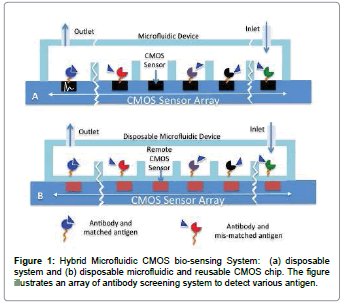Short Communication Open Access
Emerging CMOS Bio-Sensors: A Paradigm Shift
Ebrahim Ghafar-Zadeh*
Department of Electrical Engineering and Computer Science, York University, Toronto, Canada
- Corresponding Author:
- Ghafar-Zadeh E
Department of Electrical Engineering and Computer Science
York University, Toronto, Canada
Tel: +416 736-2100
E-mail: egz@cse.yorku.ca
Received Date: May 21, 2015; Accepted Date: June 29, 2015; Published Date: June j04, 2015
Citation: Ghafar-Zadeh E (2015) Emerging CMOS Bio-Sensors: A Paradigm Shift. Biosens J 4:115. doi:10.4172/2090-4967.1000115
Copyright: © 2015 Ghafar-Zadeh E. This is an open-access article distributed under the terms of the Creative Commons Attribution License, which permits unrestricted use, distribution, and reproduction in any medium, provided the original author and source are credited.
Visit for more related articles at Biosensors Journal
Abstract
It is well-established fact that the CMOS foundries, with several trillion dollars investment, are efficient mass-production platforms that lowered the cost of microelectronic devices, low enough to make most of consumer electronic products affordable to the endusers. As to their scale of integration, today’s foundry processes have reached the threshold of 15 nm and hence they allow for the making of highly dense systems featuring millions of active elements such as Ion-Selective-Field-Effect-Transistors FET (ISFET).
Short Communication
Recently, the state-of-the-art, first single-use Complementary- Metal-Oxide-Semiconductor (CMOS) based DNA sequencing device [1], featuring millions of pH sensors has greatly demonstrated the advantage of using standard CMOS technologies in life science applications.
It is well-established fact that the CMOS foundries, with several trillion dollars investment, are efficient mass-production platforms that lowered the cost of microelectronic devices, low enough to make most of consumer electronic products affordable to the endusers. As to their scale of integration, today’s foundry processes have reached the threshold of 15 nm and hence they allow for the making of highly dense systems featuring millions of active elements such as Ion-Selective-Field-Effect-Transistors FET (ISFET). On other words, CMOS technology by offering the advantages of distinct costs and highly integrated sensors and circuits, experiences a paradigm shift toward life science application.
Nevertheless, despite the great advances achieved in developing a variety of CMOS based biosensors using magnetic [2], capacitive [3] or other electrochemical [4] techniques, little progress has been made by industrial researchers in bringing viably marketable devices to the level of mass production for various of bio-sensing applications.
The main obstacles facing CMOS designers for commercializing their bio-sensing devices are bio-interface-related. Indeed, CMOS should not directly come into contact with analytes (e.g., mRNA, Cells and Proteins) and when contact takes place; such devices are deemed to be single-use only due to the contamination of CMOS chip by biological sample and the uncertainty and instability of microelectronic characteristics when the fluids impinge on them. And vice-versa, residues from synthesis and fabrication phases may affect biological samples in an adverse manner, adsorption-driven concentration changes being the least troublesome; however it causes inter-devices variability of measurement outcomes.
In order to overcome these obstacles, the implementation of contactfree CMOS biosensor is a key solution to address this unmet challenge. For instance, a Radio-Frequency (RF) CMOS chip can be designed to detect magnetic resonance signal generated from a miniaturized Nuclear Magnetic Resonance (NMR) system without a direct contact with the biological sample [5]. Among a few efforts made, based on remote magnetic sensing, researchers from Harvard University deployed developed landmark hybrid microfluidic/CMOS chips for NMR relaxometry and manipulation purposes [6,7]. However, in these applications, the microfluidic chips were bonded on CMOS chip permanently and CMOS chip was a single-use device (Figure1).
Novel contact free microfluidic devices incorporated with reusable CMOS biosensors is the main objective of CMOS biosensors particularly for point-ofcare diagnostics applications whose potential market is predicted to reach $23 billion by the year 2023. The search for such a contact-free hybrid microfluidic/ CMOS techniques is an essential step to take in view of developing novel affordable devices, so that, the cost of each experiment will be solely dictated by the fabrication fees of the microfluidic part rather than the whole hybrid system.
References
- Rothberg JM, Hinz W, Rearick TM, et al. (2011) An integrated semiconductor device enabling non-optical genome sequencing. Nature. 475:345-372.
- Hall DA, Gaster RS, Makinwa KAA, et al. (2013) A 256 Pixel Magnetoresistive Biosensor Microarray in 0.18 µm CMOS. IEEE Journal of Solid-State Circuits. 48:1290-1301.
- Ghafar-Zadeh E, et al. (2010) Bacteria growth monitoring through a differential CMOS capacitive sensor. IEEE Transactions on Biomedical Circuits and Systems. 4:232-238.
- Huang Y, et al. (2013) Lab-on-CMOS integration of microfluidics and electrochemical sensors. Lab on a Chip. 13:3929-3934.
- Pourmodheji H, Ghafar-Zadeh E, Magierowski S (2015) Active Nuclear Magnetic Resonance Probe: a New Multidiciplinary Approach Toward Highly Sensitive Bio-molecular Spectroscopy. IEEE International Symposium on Circuits and Systems (ISCAS).Lisbon, Portuguese.
- Hakho L, et al. (2008) Chip–NMR biosensor for detection and molecular analysis of cells. Nature Medicine. 14.
- Lee H, et al. (2007) Integrated cell manipulation system CMOS/microfluidic hybrid Integrated cell manipulation system CMOS/microfluidic hybrid. Lab on Chip. 7:331-337.
Relevant Topics
- Amperometric Biosensors
- Biomedical Sensor
- Bioreceptors
- Biosensors Application
- Biosensors Companies and Market Analysis
- Biotransducer
- Chemical Sensors
- Colorimetric Biosensors
- DNA Biosensors
- Electrochemical Biosensors
- Glucose Biosensors
- Graphene Biosensors
- Imaging Sensors
- Microbial Biosensors
- Nucleic Acid Interactions
- Optical Biosensor
- Piezo Electric Sensor
- Potentiometric Biosensors
- Surface Attachment of the Biological Elements
- Surface Plasmon Resonance
- Transducers
Recommended Journals
Article Tools
Article Usage
- Total views: 15265
- [From(publication date):
June-2015 - Aug 16, 2025] - Breakdown by view type
- HTML page views : 10517
- PDF downloads : 4748

